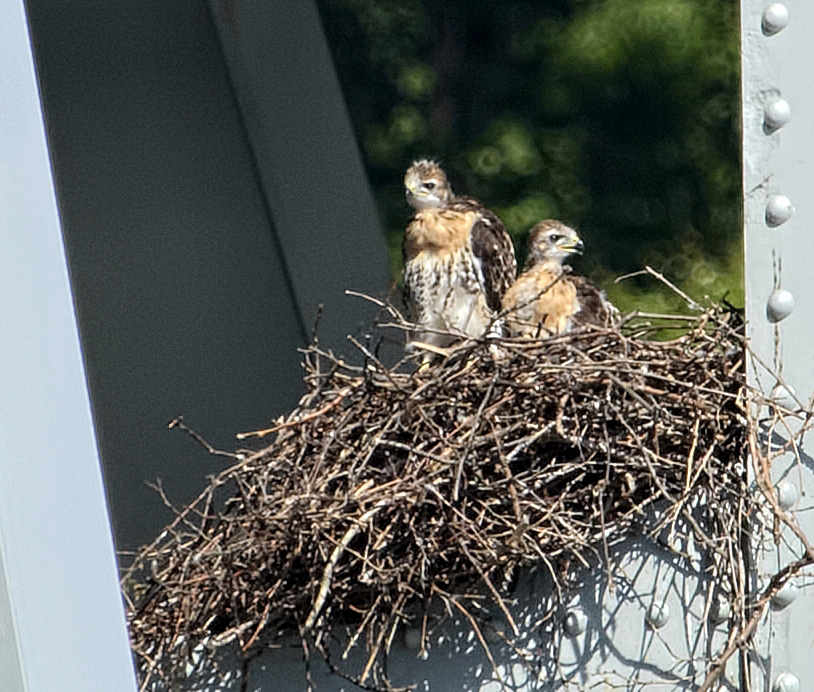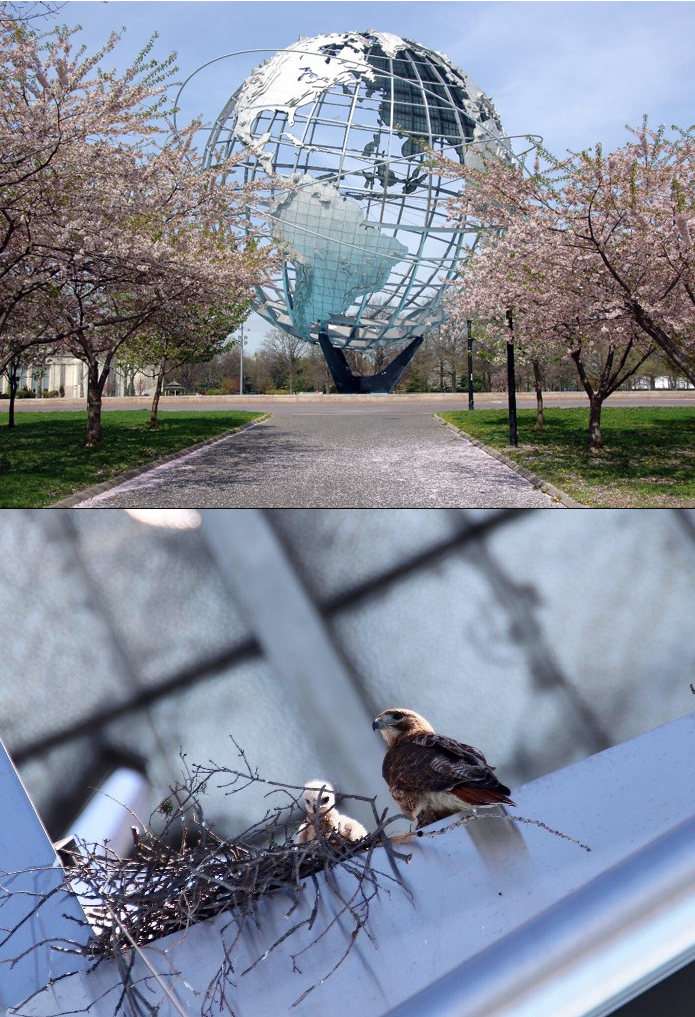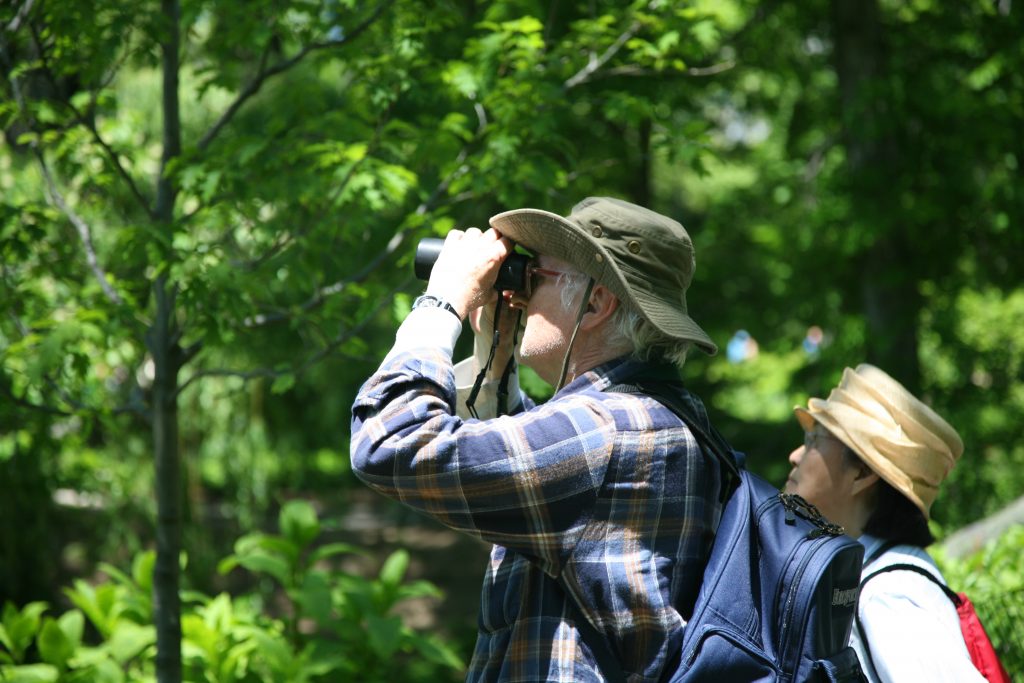Monitoring Birds of Prey in New York City
September 13, 2019
City Siblings
Two Red-tailed Hawk siblings keep an eye out for danger from their high-rise nest.
By Katie Leung and Sunny Corrao, NYC Parks’ Wildlife Unit
Flushing Meadows Corona Park is the largest park in the borough of Queens. It is home to Citi Field, the Queens Museum of Art, countless family picnics and barbecues—and a pair of Red-tailed Hawks. New York City Parks’ Wildlife Unit has been tracking raptors nesting in NYC for three years now. This pair—who nested inside the iconic Unisphere—is one of 15 pairs of Red-tailed Hawks that nested on human-made structures in New York City in 2019. This is a smart adaptation on the part of urban hawks. These structures are usually quite stable, and provide them with open views and excellent vantage points for hunting.
However, life in this metropolis is not without its dangers. Red-tailed Hawks and other raptors are vulnerable to many hazards. One hazard is secondary rodenticide poisoning (i.e., hawks being poisoned by eating poisoned rodents). One of the goals of monitoring raptor nests is to help City agencies make informed decisions of where and when to suspend rodenticide use. In addition, we hope to learn more about raptor breeding and nesting behavior within an urban environment.
Why we started citizen science

Where In The World
A female Red-tailed Hawk and her chick call the iconic Unisphere home.
Since the start of the raptor nest monitoring project, our goal has been to compile the most comprehensive list of nesting raptors in all five boroughs of New York City. This area spans over 300 square miles. In order to meet this goal, we knew we would need help from local residents. In 2018, we reached out to local birdwatching communities and partner organizations in NYC to recruit citizen-science participants. We then introduced these citywide participants to NestWatch, a citizen-science project designed to track the success of nesting birds. As a collective group, we have been adding our observations to the database for two breeding seasons now.
In NYC, the nesting season extends from February to August. During this time, at least one citizen-science monitor visits and documents each nest. Each week they dedicate several hours from their busy schedules to closely document all nesting activity. They note important events like adult courting and juvenile fledging. The addition of these citizen-science monitors has helped us meet our monitoring goals. It has also expanded the number of nests that we have found.
Although most monitors were already experienced birdwatchers before joining the project, they still found the monitoring process enriching. They expressed how much they learned about raptor behavior from their observations, and from speaking to one another. The project even provided one volunteer with the opportunity to see hawk hatchlings for the first time! It was undoubtedly a great opportunity for participants to experience the beginnings of these amazing birds’ lives. And some of the photos they captured were stunning—including this shot from 2019 of a mother and her chick on the Unisphere (photos, right).

Bird Lovers Needed
Birdwatchers prowl Central Park in New York City. These observations can help biologists!
Success of the program
When we started this citizen-science program in 2018, participants monitored 35 nests and reported 52 successful fledglings. This year they monitored 42 nests and reported 71 fledglings, a 37% increase. Participants confirmed that the hawk pair at the Unisphere had another successful breeding season in 2019. They had one juvenile fledge in July.
We looked at all the nest site locations chosen by Red-tailed Hawks this season. Just over half chose to nest in or on a human-made structure—including the pair at the Unisphere. Will this trend continue? Future data collection with the help of citizen-science nest monitors will allow us to answer this question. It will also increase our understanding of birds of prey living in an urban environment. Continuing this project also contributes to the larger study of nesting birds being conducted by NestWatch.
The success of this project would not have been possible without dedication and enthusiasm from our monitors. One of our monitors, who observed a nest in busy Prospect Park, reflected on his experience with the project. “It definitely inspired me to be more aware of my surroundings,” he said. “Even in urban parks, there’s so much wildlife to discover.”
We are always on the lookout for new citizen science raptor monitors. If you live in NYC and would like to be a part of the Wildlife Unit’s raptor nest monitoring project, please reach out to Sunny Corrao (Sunny.Corrao@parks.nyc.gov). To learn more about urban wildlife in New York City, visit www.nyc.gov/wildlife.

14 comments on “Monitoring Birds of Prey in New York City”
Urban hawks is a topic that is near to my own experience here in my city of Ottawa, Ontario, Canada. I live in a pair of 12 story buildings that has a red-tail hawk that hunts, perches, and one year nested on our roof and raised a brood. The red-tail is a year round resident, and indeed the best look at her [?] was during an early Spring snowstorm when she perched on my balcony rail which was at least sheltered from the wind for about 2 hours. I have never been that close to a red-tail before or since! In the last month or two I have also observed a sharp shinned hawk kiting just off my 9th story balcony; and merlin hunting cries can be heard at times at well. There is plenty of green space about a half mile from this building along the banks of a large river, so I assume that also makes this area attractive to the hawks too.
Hi Dana, sounds like you love your resident hawks! Ottawa is a beautiful city. Have you tried asking your building management if they use rodenticides to control rats in the building? Maybe if you brought the issue to their attention, they would let you know their practices. saferodentcontrol.org has more info on safe alternatives. Cheers, Robyn
Iwish there could be information on safe rodent control
Hi Barbara, Have you checked out http://www.saferodentcontrol.org? There is some useful information there. Thanks for reading!
An adult red-tailed hawk and a smaller one have been seen in the Rego Park area over the past few months. It is known to frequent the corner of Saunders Street and 62nd Ave. Curious if anyone has reported seeing a nest in the area. Also, what do red-tailed hawks eat? We’ve come across a pigeon carcass hanging in the trees but, so far, no squirrels. Do they eat squirrels? The only reason I ask is that both pigeons and squirrels are plentiful in the surrounding area and I’m curious what could be drawing the hawk to a neighborhood where I’ve never seen one before.
Hi Bradd, Red-tailed Hawks mainly eat small mammals (from voles/mice up to ground squirrels and snowshoe hares), but also eat birds (including those as large as pheasants), snakes, and carrion. You can learn more about this species here.
Saw a red tailed hawk yesterday in the Broadway North neighborhood of Flushing. Sitting in the tall trees and soaring from tree to tree. Another could be seen flying high up in the sky a bit farther southeast. Possibly courtship. I have not seen them again today but will be on the lookout for a nest. This would be a hospitable area due to the tall trees and abundance of squirrels and birds.
Like to report hawk building nest in citi field light tower for more info call me at 516 458 1084 thanks
Hi John, if you’d like to report data on this nest, you can sign up for a free account with NestWatch, report the location of the nest and then enter data as the breeding season progresses. Alternatively, you can reach out to a local bird organization who may be bale to tell you who, if anyone, is already monitoring the nest. If you have further questions, please email nestwatch@cornell.edu.
Like to report red hawk building nest in light tower in citi field
I am from Billings MT and have been given the opportunity to start a nest watch program for Kestrels within the city limits. Businesses would like to partner with this to control the pigeon population. Is there any research on Kestrels nesting within cities and successful Nest watch programs.
Should I focus on other raptors for pigeon control? Is there any research that shows this as a successful program? We have many Kestrels around the city, I see them often, which is why I thought of them. While they are migratory in our area, could they be effective with pigeons?
Thanks
Heather Gaitonde
Hi Heather, American Kestrel diets contain primarily insects and small rodents. They do occasionally prey upon small songbirds, but pigeons are both larger and heavier on average than an adult kestrel, so it’s very unlikely the kestrels would have any impact on the pigeon population. The most common avian predators for Rock Pigeons are Eastern Screech Owls, Great Horned Owls, Peregrine Falcons, Prairie Falcons, and a variety of others. Our website does have nesting structure plans for both Eastern Screech and Great Horned Owls, though it’s hard to know for sure whether they would be attracted to live within city limits. Both owl species prefer to nest in forest and woodlands, though screech owls are more likely to nest near towns. I can’t say whether installing nest boxes near your city would help control the pigeon population to a noticeable amount, but all of the information you need to place the boxes are in the links above. Note that the “minimum spacing” section refers to how far apart the nesting structures should be from another nesting structure meant for the same species. If you have further questions, please email us at nestwatch@cornell.edu, as these comment sections are not regularly monitored.
Good Morning from the Ditmars Steinway area of Astoria, Queens, NY. How do I report bird sightings? We have a tree in our backyard with lots of various birds in it. I just saw a raptor hunting a pigeon by the tree. It’s pale grey/tan and white and slim — approx. 18 to 20 inches tall. I think it might be a Cooper’s Hawk.
Hi Jeanne, NestWatch participation involves monitoring bird nests. If you’d like to report bird sightings, I suggest checking out eBird, another citizen science project here at the Cornell Lab. You can learn more about eBird here.
My hope would be authorities would consider a genetic approach to rat control my introducing sterile rats into their colonies, there by the hope to not need rodenticide to control them and to save the red tailed Hawks in the process.